NEWS
Safer Tomorrow thought leadership series: Debbie Cavaldoro
Campaigns |Published: Dec 8, 2025

As PSS comes to the end of a year of focus on a safer tomorrow for ports, our CEO Debbie Cavaldoro reflects on what tomorrow can teach us about today.
When I first envisioned a year-long campaign centred on how we secure a safer tomorrow for ports, I imagined conversations full of futuristic scenes: remote pilotage and self-docking vessels, port operations controlled from darkened rooms of screens, and drones the size of flying saucers offloading containers.
The reality was, I’m glad to say, far more grounded, practical and, most importantly, within our grasp. The port landscape is changing, and those innovations may well shape what comes next, but a safer tomorrow doesn’t depend on technologies still decades away. It starts with the choices we make today.
In all the conversations I had about what a safer tomorrow looks like, company culture — and crucially not just safety culture — emerged as the defining theme. Culture change involves everyone, from senior leadership to port operative apprentices and every team in between. The sector is increasingly recognising that the everyday behaviours, decisions, and interactions across our ports are what shape the safety outcomes we see.

Building on that, the question becomes how we turn this shared understanding into action. As a sector we need to ask ourselves daily: what did we do well today that we can strengthen tomorrow? What did we learn that will help us create a safer future? And how do we empower everyone to speak up and call out concerns so that each of us goes home safe at the end of the day?
Over the past year, certain principles have surfaced repeatedly:
“The standards we walk past are the standards we accept.”
“Safety culture is the output of good company culture, not the driver.”
“It’s not compliance for its own sake, but shared accountability.”
“Safety must become ‘the way we do things here’.”
“It’s not about asking how the H&S team will make us safer, but how I can make everyone safer.”
These all contain truth and show we understand the direction of travel. Each phrase reflects the mindset shift our industry is striving for: from rules to responsibility, from process to culture, and from delegation to ownership. So why are ports not seen as centres of safety excellence?
When I visit ports, the culture is clear before I’ve even reached the port. It’s visible in the safety induction received in the days before the visit, it’s clear from the incident reporting posters on the wall, it shows in the painted walkways, and it comes alive when meeting managers, operatives and contractors during a port tour. It is not difficult to spot when ‘safety first’ is just a slogan, and the buck stops with chief executives and senior leadership teams. Safety moments and reports should be at the top of every agenda, because that frames the entire direction of the meeting. Where leaders are asking how safe, and not how much or how fast, the priorities are set for the whole company.
A safer tomorrow will be built on:
- Visible leadership, that champions safety as a shared value rather than a checklist.
- Psychological safety, where everyone, regardless of role, can speak up, share learning, and stop work without fear.
- Inclusive development, ensuring that apprentices, seasoned professionals, and contractors alike understand not only the rules, but the ‘why’ behind them.
- Behavioural insight, asking not just ‘what happened?’ but ‘why did it make sense at the time?’ to design better systems and prioritise safety.
- Technology as an enabler, used to enhance human capability rather than replace it.
Tomorrow is a journey
No one believes they have ‘safety solved’. Each is at a different point on its journey; what matters is that the journey is underway. Reporting near misses must be viewed as a positive act that drives improvement, not a trigger for blame. We need to shift from a reactive mindset, learning only from what failed, to a proactive mindset that imagines what could go right. And we must reinforce the message that the safest way is also the most efficient and cost-effective way to ensure everyone gets home safely.
We know that change is hard and needs time and resource to make it happen – and to make it stick. Changing the culture in ports depends on the buy-in of every single person who calls the port their workplace, including those whose work only brings them to the port for short periods – the hauliers, the seafarers, the contractors and the fishers, to name but a few. This raises the question of how you can affect the culture of people not directly under your employ. But this not simply another excuse to put real change into the ‘Too Hard’ cupboard.
If company culture is the vehicle that carries us to a safer tomorrow, then skilled staff are the road beneath it. And just as the best roads are well-maintained, reliable and continuous, our people need to be well-trained, resilient and supported so the whole organisation travels together towards its destination.
Which makes PSS the motorway service station! We are here for members along the way. Our guidance materials provide the background needed for the journey ahead, our various communications share what others have learnt along the way, and our safety group, skills group, and other events give staff a place to come together to share their roadmaps, work out the best routes, and refresh themselves for the tasks ahead.

Technology will evolve. Our ports will modernise. But the culture we build now will determine how safe, inclusive and sustainable that future really is. For PSS members I hope the message is clear – through collaboration we can improve port skills and port safety to make a safer tomorrow.
